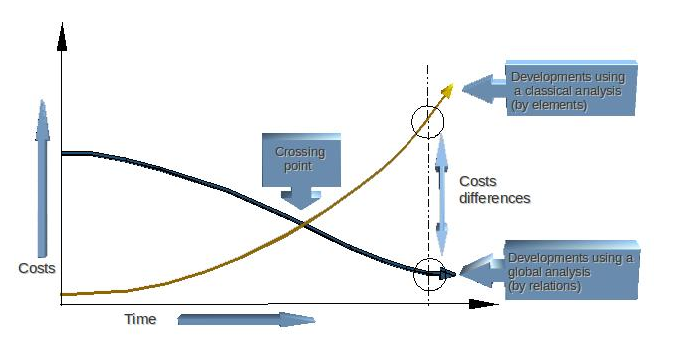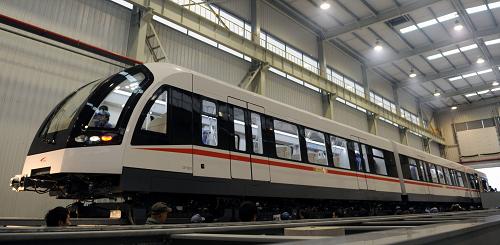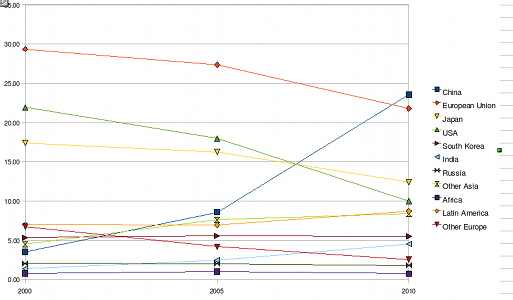Description of the method of analysis

The best way to explain our method of analysis is with an example.
Let us analyse the cost of a product (very simplified). The method we call method by elements is the one that analyses the enterprise as an element isolated from processes in the outside world. Only the impact of internal costs will be taken into account. For instance let us define for a production of 20 products this cost allocation. :
Table
1
Energy and raw material
:
30
Depreciation of machines and technology : 30
Depreciation
of
construction
:
5
Administrative
costs
:
3
Financial costs
:
2
Salaries
: 30
Total
:
100
for 20
products, so a cost of 5 for each product
In front of this table, a classical analyst will say that as he cannot control the cost of energy and raw material and as machines and technology are an unavoidable cost, the easiest thing he can do to cut cost is to lower the salaries.
Let us take the same situation with another point of view. The costs of one product is 100/20 = 5. If we say that productivity is the number of products made by unit of time , what happens to costs when productivity is increased ? Let us make that simple and multiply productivity by 5. Instead of 20 units, we will produce 100 units in the same time. It is most likely (but not always true) that the cost of energy and raw material will be multiply by the same amount. We get this new table :
Table 2
Energy
and raw material
: 150
Depreciation
of machines and technology
: 30
Depreciation of
construction
:
5
Administrative
costs
:
3
Financial costs
: 2
Salaries : 30
Total
:
220
for 100 products, so a cost of 2.2 for each product
In the first example (table 1), if salaries were reduced to 0 , total cost would be 70 for 20 units or 3.5 for each product.
Even by reducing salaries to 0, it would not be possible to be competitive. Interesting, no ?
You will say that with the same machines and technology , the same number of people, it is not possible to multiply productivity by 5...
Let us try a relatively simple analysis...
Suppose we want to create a computer to automate the management of an enterprise.
The sale department needs a way to manage clients. The computer department create a special program for the sale department. Later another department asks for a program to manage providers, the marketing department wants a program to manage prospects and so on... After a few years the enterprise has 5 different programs managing a more or less similar type of information. Information about the same person can be stored in 5 different databases and not up to date in each of them...To avoid some of those types of problems, the sale department ask to the computer department to create a link (an interface) between their database and the marketing department database. After some time, the same thing happens between other departments. At the end, there are numerous databases , programs, interfaces with loopholes... Without even speaking about maintenance costs.
How would we automate those departments using an analysis by relations ? (simplified) We would immediately see that the main process is about relations between the enterprise and people, with a different point of view according to which department is interested. There are a number of Informations that describe people like name, location, phone number, E-mail, etc... Thus the computer department will create a program that can handle all basic information related to people and display a list of people or detailed information for one person. If we create a server object (program) that can answer to any request to display the detailed information or the list so user can choose from and reply to the calling program giving all needed information related to the person the user has chosen then we have already something that can be used by any department, If on top of that we add the ability to use any other object (program) specific to each department after the user has selected a person we have a very flexible tool. The computer department will only need to create new objects limited to those specific informations for each department. The cost of the first server may be higher than the cost of a simple program for a one department (which is not even sure), but later the additional cost will be lower and lower. The cost of this type of development will follow the curve of development based on an analysis by relation. Note that in this example, the cost of energy, material, machines, technology is even the same... The only difference is knowledge. In the computer department, you need to hire people with a much better level of knowledge. They may cost more in salary but normally their productivity will be much higher so not only the cost of automation will be reduced thanks to a better technology but even the cost of the computer department will also reduced thanks to a better productivity. The problem is you need people with a better level of knowledge ...up to the top and this is one of the sticking point. Many managers are financial people with a poor technical background, a short span of attention and a relatively short term view (3 months, rarely one year), they don't like to hire people who know too much about technology especially about computer science because they are afraid of loosing their power about a management system they will not fully understand. We have a contradiction between the need of the new technological world which is more and more a knowledge based economy and Western societies which are financial based economy.
By only changing the method of analysis, productivity can be multiply by 5 or more. In fact the more complex the problem the more the difference. This type of analysis can also by applied to industrial production but this is more complex and is outside the scope of this page. (If you want more information, contact us)
But the impact of an analysis by relations does not stop there !
This type of analysis does not cut off the enterprise from outside forces. For instance, property speculation must be accounted for. If housing prices are multiplied by two, it means that cost of new workshops will be higher but also that housing costs for the workers will be higher. This in turn means that soon or later it will be necessary to increase salaries. It is possible that with lower wages, workers, employees in an other country may have a better buying power. If we study the direct and indirect impact of financial speculation we will discover that it may be worse than productivity differences. The aim of this page is not to carry out a detailed study of all those problems but to call attention to some important points.
In fact financial speculation is what impacts most costs in our countries, even before housing speculation.
If we try to remove those costs in the first table we would get something like that :
Table 1b
Energy
and raw material
: 25
Depreciation of
machines and technology : 15
Depreciation of
construction
:
2
Administrative
costs
:
2
Financial costs
:
0
Salaries
: 30
Total : 74
for 20 products, so a cost of 3.7 for each product
and for the second table
Table 2b
Energy and raw material
: 125
Depreciation of machines and technology :
15
Depreciation of
construction
:
2
Administrative
costs
:
2
Financial costs
:
0
Salaries
: 30
Total
:
174
for 100 products, so a cost of 1.74 for each product
What is the possibility to stay competitive using a method of analysis by elements ? Null !!
Interesting question ! Why is the method of analysis by relations not used in the West ? But even better : what if the success of China was based on a similar method of analysis ???
Another consequence ! If the cost of a product is reduced from 5 to 1.74 (divided by 2,87) and salaries are only divided by 2 this means that this reduced salary will still have a better buying power ! Let us introduce This new salary (15) in table 2b. The cost of one product is reduced to 1.59 , which means that despite having a lower salary the people there will get a buying power 50% greater than the one with the higher salary.
Unfortunately this is only a simplified view of the problem. There are many other points we have not even said anything about.
I imagine you are thinking « is it possible that we are so stupid compare to the Chinese (and others) ? This does not seem possible ! In fact this is not the real question . Then why do we use this method of analysis by elements ?
In the West, the purpose of the economy is not at all to develop a country or the real economy but a way for some individuals to get as much money as possible, as quickly as possible together with a quest for power. It is not the efficiency of the collectivity that important but the interest of the element which is the individual. This is the real difference between the West and some other civilization, up to the point that Western people can not even imagine that other people may think differently. In the Asian societies, people have learnt through several thousand years of civilisation that what you are today is the consequence of a very long history, a long evolution and of the result of millions of people working together. Thus when some individual try to get some short term profit which are harmful for the collectivity they run into troubles sooner or later. They think globally and in the long run while in the West if somebody finds a way to get rich quickly, he does not think about the long term impact of his action upon other people, the country, the future, even for his children or very often even himself. « We will see later !! » This culture based on short term individual gain is at the base of the method of analysis by elements because it make it possible to get more faster, at least for some individuals.
A global analysis will show the long term impact of the actions, some may be disastrous : crisis, wars and at the end the downfall of this type of economy.
It is thanks to the method of analysis by relations that I was able to forecast the downfall of Lehman Brothers 3 months in advance or today's crisis 10 years ahead.
One of the problem is that shareholders, like all people living from financial products, wants to earn as much money as possible as quickly as possible. Do you think those shareholders are interested in knowing something about the ability of an enterprise to survive in ten years ? They want money now and if they think that their business will go down in 10 years they will just buy CDS against their own business and in this way earn even more money when it goes under ! Destroying means of production may be a way to earn money in our financial world !


